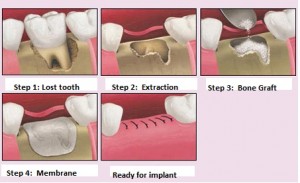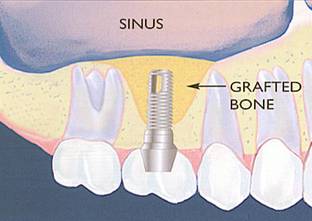Sometimes referred to as bone augmentation, bone grafting is used to replace bone tissue, which can occur by tooth loss, periodontal disease, cavities or infection, injury or trauma.
 It is a procedure that involves adding bone or bone like materials to the jaw in order to be able to place in dental implants. If a person does not have enough bone where a tooth has been extracted or has been lost, a dental implant cannot be placed in as it is possible it with not hold in the jaw.
It is a procedure that involves adding bone or bone like materials to the jaw in order to be able to place in dental implants. If a person does not have enough bone where a tooth has been extracted or has been lost, a dental implant cannot be placed in as it is possible it with not hold in the jaw.
A patient will need a dental implant to replace a missing tooth, whether it was extracted or it broke time ago or if needs to be extracted and replaced immediately. The doctor will determine whether or not there is enough bone to place the implant, however, in most cases, the bone graft is necessary.
There are four types of bone grafts that are most commonly used:
First, there are autografts (or autogenous grafts), in which bone is harvested from the patient´s own body, usually from the chin in dental procedures. This type of bone graft has proven to be the most successful, since it is from the patient´s body, there is no other graft as compatible.
There are also allografts (or allogenous grafts), which are taken from human donors, and are converted by the patient´s own bone into natural bone. They undergo numerous controls and sterilization processes; they are often chosen to avoid a second surgery procedure other than the implant placement.
Then, there are xenografts, or bone grafts taken from animals, most commonly from cow or know as ¨bovine¨. These go through strict processes in order to become biocompatible and sterile for future use.
Lastly, there are alloplastic grafts, made from artificial or synthetic materials either calcium phosphates or hydroxy apatite, that stimulate the patient´s body to form natural bone. It is thought that alloplastic grafts have the least success rates of all the types of bone grafts; however, it is the one with least probabilities or risk of infections.
Bone grafts offers patients who have had extractions the opportunity to create an area filled with bone or bone like materials in order to be able to place in dental implants or to restore defects in the bone. They are very successful and it is an excellent option for being a good candidate for implants or any other dental restoration procedure.
By Prisma Dental
For more information contact Prisma Dental at their website. Prisma Dental Website

